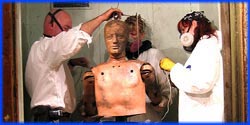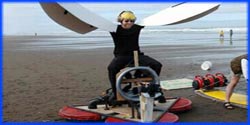


Premier Date: April 14, 2010
busted
The MythBusters started by striking a fake human head with both full and empty bottles. The results showed that the full bottle struck with an average G-force of 28.1, while the empty bottle struck with an average of 22.7 Gs. However, to get more consistent results, Adam built a machine to simulate a swinging arm. In their second test, the MythBusters used the robot arm to strike a container with gelatin representing the human brain. Analyzing the results, they found that full bottle still delivered more force to the brain than the empty bottle, making an injury like a concussion more likely. However, the MythBusters decided to factor in other injuries such as skull fractures and lacerations. They built a container to more closely simulate a human skull. The full bottles were able to smash the skull, while the empty bottle could not even crack it. They then used artificial skin and blood to test for lacerations. However, the full and empty bottles caused the same amount of lacerations. The full bottle was clearly more capable of causing damage than the empty bottle.
busted
For comparison, the Build Team fired a Civil War parrot gun of similar size to the cannons described in the myth to measure its muzzle velocity, which was 389 miles per hour. Because there are two separate versions of the myth, originating from Sweden and Ireland, the Build Team decided to test both designs. The Swedish cannon consisted of a copper core wrapped in leather and iron bands, while the Irish cannon was built completely out of leather. The Swedish cannon managed to fire its cannonball at a speed of 450 miles per hour, but blew out its breech in the process. The Irish cannon failed spectacularly, with the breech blowing out, the cannonball moving only two feet, and the barrel completely unravelling, making a second shot impossible. They then built a third leather cannon and reinforced it with significantly more leather. They also lubricated the barrel to make it easier for the cannonball to fire. The cannon managed to fire successfully, but the cannonball could only achieve a speed of 52 miles per hour. While the cannon was still structurally intact, the barrel was too damaged for a second shot.
Previous: Episode 140: Spy Car Escape